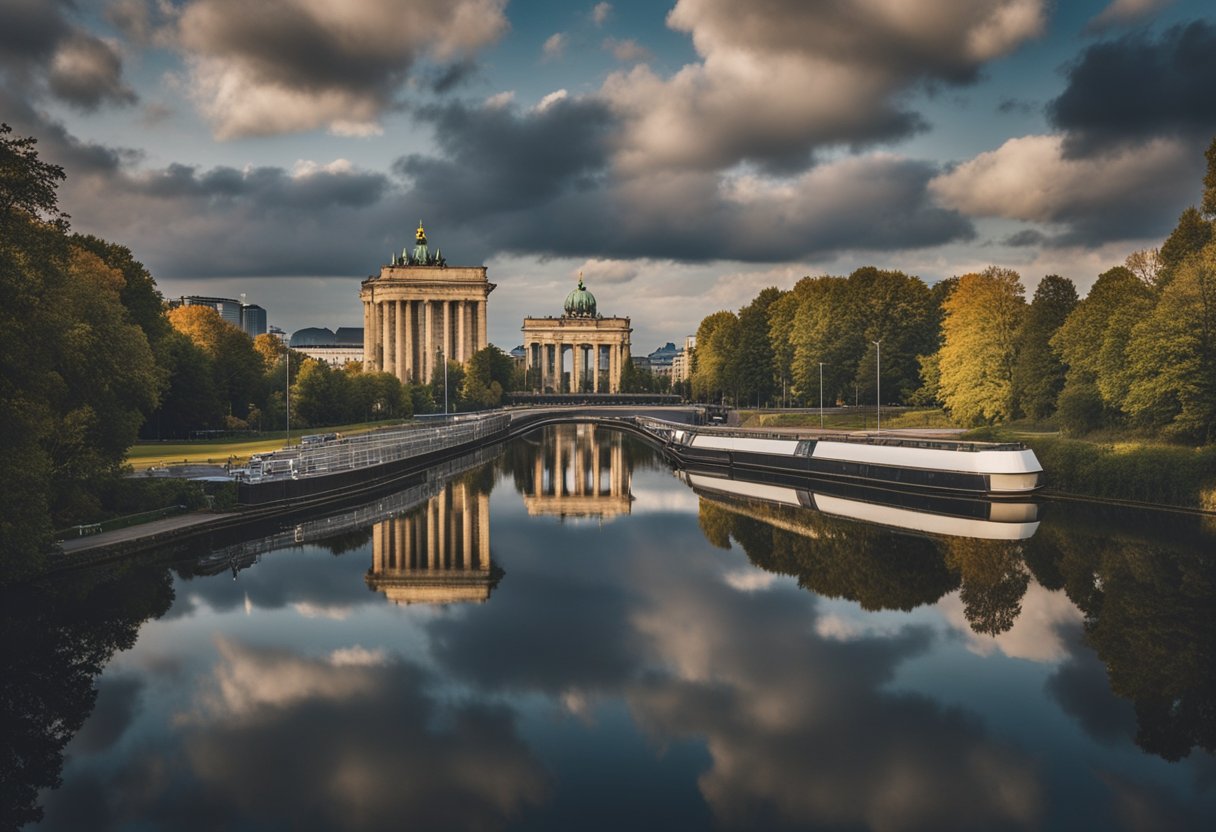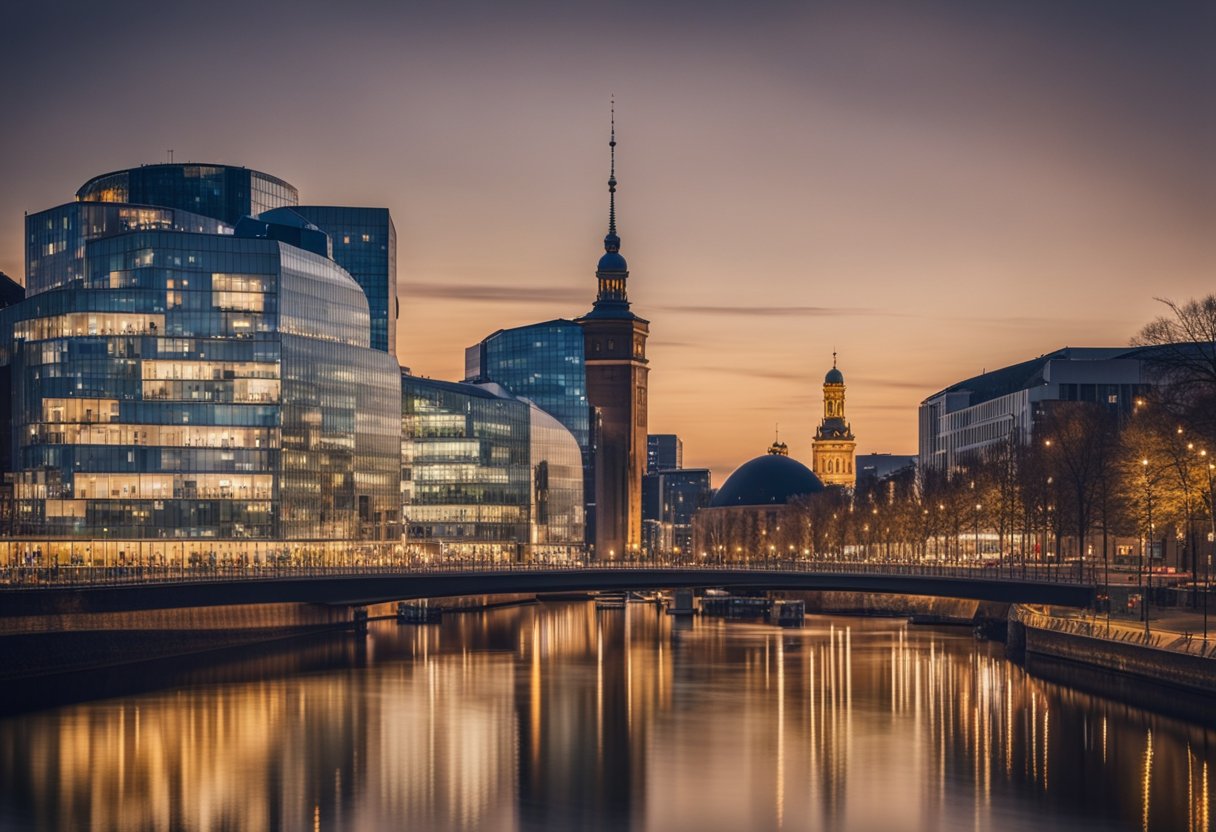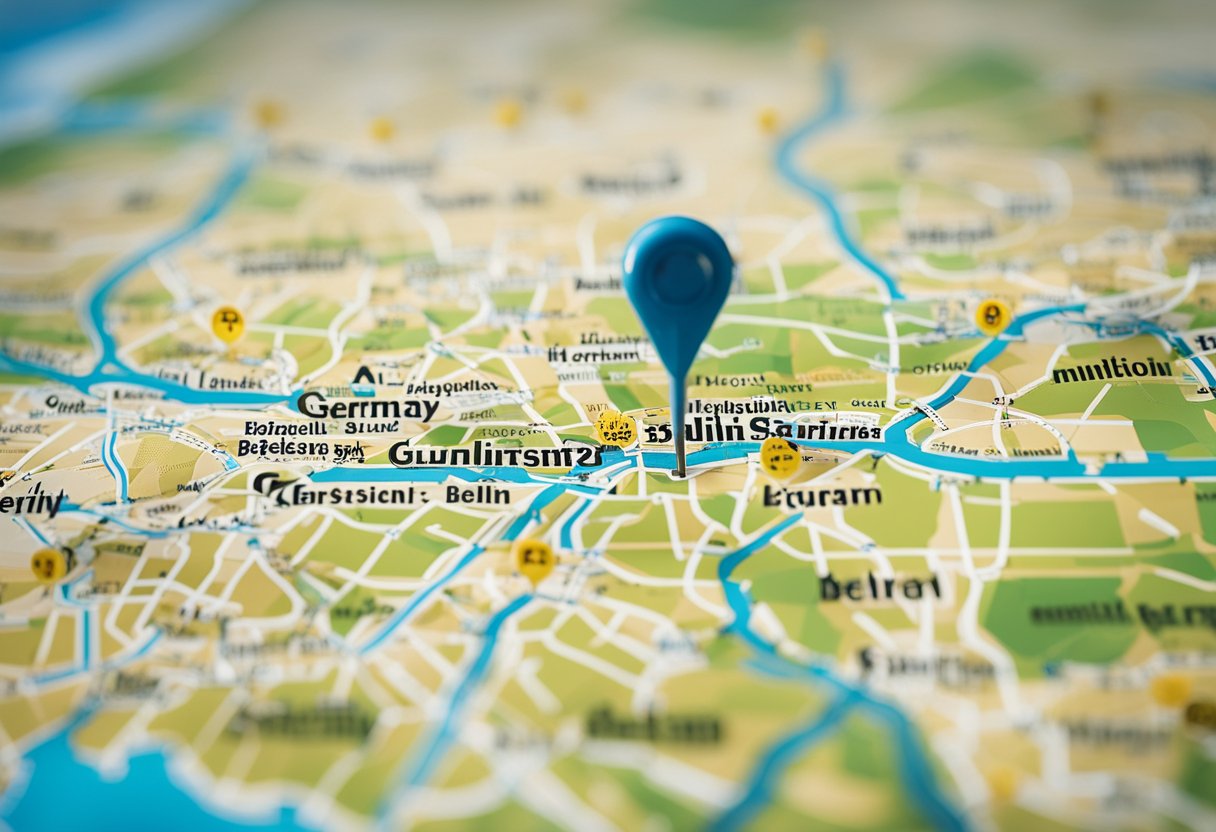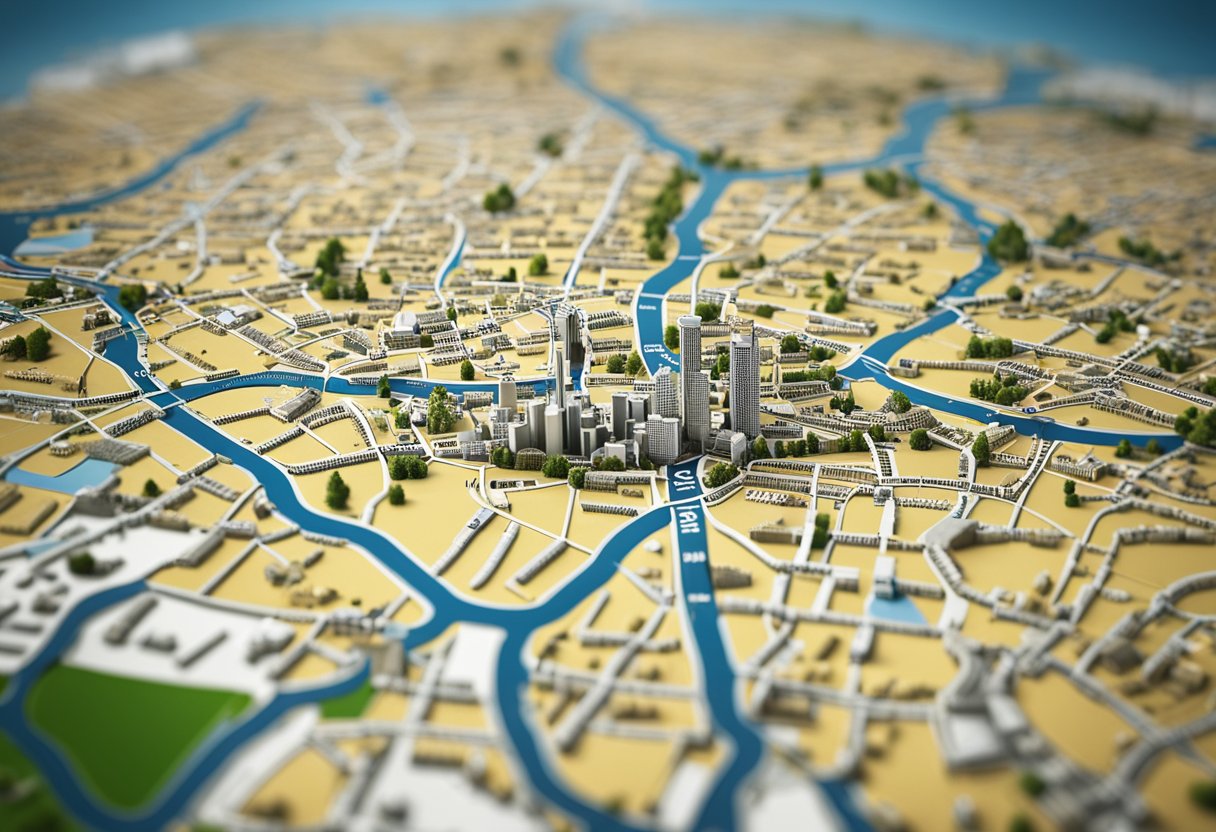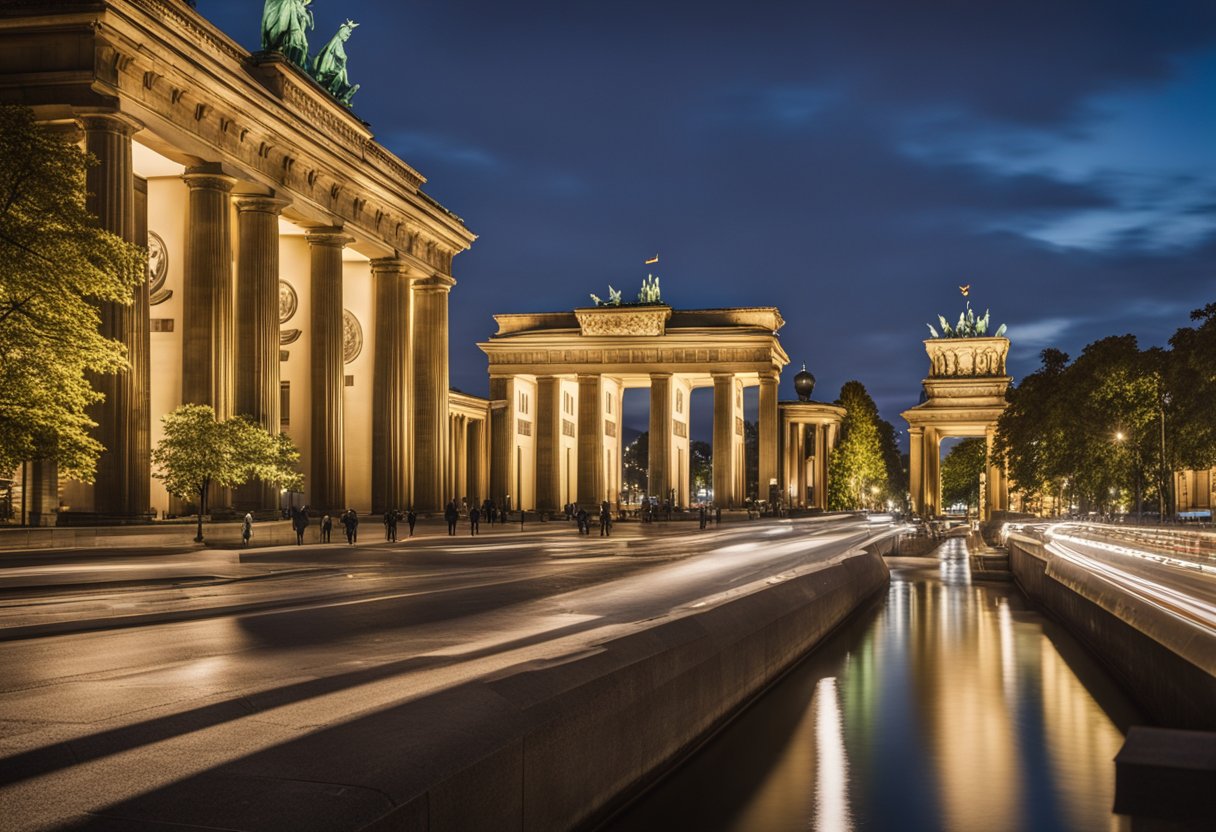Berlin within Germany is the capital and largest city, holding a key position in the country’s geography and history.
Situated in the northeastern part of the country, it anchors the vast North German Plain and serves as a central hub for politics, culture, and science.
Known for its rich cultural scene and tumultuous past, the city is recognized not just as Germany’s political center but also as a melting pot of creativity and innovation.
The city is entirely surrounded by the state of Brandenburg, with the nearest city being Potsdam, the state’s capital. Despite its insular location within the state, Berlin maintains its status as a separate federal state, illustrating the unique administrative structure of Germany.
Residents of Berlin, often called Berliners, take pride in their city, which has overcome historical adversities to emerge as a vibrant and modern metropolis.
Berlin’s location places it well within the eastern region of Germany, contradicting some common misconceptions about its placement. It is neither in the southern parts of Germany nor near countries like France or the USA.
This central position within Europe has made it a significant city for international relations and a crossroads for an interconnected global society.
Geographical Context-Berlin Within Germany
Berlin stands as Germany’s capital and one of its most significant cities, both historically and in contemporary times.
This section explores Berlin’s precise geographical location within Germany, its neighboring areas, and the defining features of its topography and landscape.
Location in Germany
Berlin is situated in northeastern Germany, nestled at the heart of the European continent. It notably served as the focal point between East Berlin and West Berlin during the Cold War era.
Today, the unified city is a German federal state in its own right, with the historical core, Mitte, lying at its center.
Surrounding Areas
The city is completely surrounded by the State of Brandenburg, with the Spree River winding through its metropolitan landscape. Its insular location—being a state entirely encapsulated by another—adds a unique aspect to Berlin’s geography.
Topography and Landscape
Berlin’s topography is characterized by its position on the North German Plain, with a notably flat landscape.
The area around the city is rich with forests, parks, and even includes parts of the Spreeathen, a reference to Athens for the networks of rivers and canals similar to those in the renowned Greek city.
The city’s proximity to the Baltic Sea influences its climate and weather patterns, maintaining Berlin’s position as both a political and geographic hub in Germany and Europe.
Historical Significance
Berlin stands as a city of profound historical significance, having been at the epicenter of pivotal moments in German and European history, particularly during the 20th century.
World War II and the Division
Berlin, the capital of the German Empire, played a central role in both World Wars. Following the collapse of the Nazis at the end of World War II, the city was divided into four sectors controlled by the Allied powers.
This division laid the groundwork for what would become East Berlin and West Berlin. East Berlin served as the capital of East Germany, while Bonn became the provisional capital of West Germany during the period known as the Weimar Republic.
Berlin Wall and German Reunification
The Berlin Wall, a concrete manifestation of the Cold War, physically and ideologically split the city from 1961 until 1989. It not only divided Berlin but also symbolized the divide between East Germany and West Germany.
The fall of the Wall in November 1989 became a global symbol of freedom and precipitated the events leading to German reunification on October 3, 1990.
Following reunification, Berlin was reinstated as the capital of a united Germany, reaffirming its historical and political prominence.
Administrative Structure
Berlin’s unique position as both a city and state within Germany gives it a distinctive administrative structure that blends municipal and state-level governance.
City-State Features
Berlin is unique in the German Federal system, being a city-state, which means it functions as both a city and one of the 16 federal states (Bundesländer) in Germany.
This status gives Berlin the responsibilities and powers of both municipal and state governance. The city-state is designated as the NUTS (Nomenclature of Territorial Units for Statistics) region DE3, with the specific code DE-BE.
- Region and location within Germany: Berlin is located in northeastern Germany and is entirely surrounded by the state of Brandenburg.
- Inhabitants: Residents of Berlin are often referred to as Berliners.
Government and Legislation
Berlin’s government comprises the Abgeordnetenhaus of Berlin (state parliament) with a total of 160 seats, through which state legislation is enacted. The city-state is also represented on the federal level, with a specific number of Bundestag seats and Bundesrat votes, enabling it to influence national legislation.
Berlin is headed by a Governing Mayor, currently Kai Wegner from the CDU (Christian Democratic Union) party. As a municipality, Berlin is further divided into boroughs, each with its own borough assembly (BVV) and borough office, integrating the city’s local and state administrative functions.
Economic Profile
Berlin, Germany’s capital city, is a significant hub for both industry and tourism within the nation.
Its economy is characterized by a high gross domestic product (GDP), strong innovation sectors like information technology and electronics, and a robust academic scene anchored by its universities.
Industry and Innovation
Berlin has a dynamic economy with a growing GDP, driven by advanced sectors including information technology and electronics. The city is home to the headquarters of Siemens, a global powerhouse in electronics and electrical engineering.
Besides large corporations, Berlin fosters a vibrant startup scene, attracting entrepreneurs and investors alike. This bustling environment is supported by a network of prestigious universities and research institutions, which contribute to the city’s innovation ecosystem.
Tourism
Tourism is another cornerstone of Berlin’s economy. The city’s rich history, vibrant cultural landscape, and diverse attractions draw millions of visitors each year. From the iconic Brandenburg Gate to the remnants of the Berlin Wall, tourists flock to experience Berlin’s unique melding of past and present.
Furthermore, tourism revenue significantly contributes to the local economy, with a continual stream of new hospitality and entertainment options emerging to cater to this demand.
Cultural Highlights
Berlin is situated in northeastern Germany and is renowned for its expansive cultural landscape. The city serves as a treasure trove of history and innovation, with abundant museums and galleries, as well as a vibrant music and performing arts scene.
Museums and Galleries
Berlin is home to Museum Island, a UNESCO World Heritage site, which hosts a collection of five historically significant museums. The Berlin Cathedral stands gracefully nearby, adding to the cultural magnificence of the location.
Kreuzberg is another neighborhood that boasts an eclectic mix of modern galleries and cultural institutions, reflecting the city’s multifaceted art scene.
Music and Performing Arts
The Berlin Philharmonic is one of the world’s leading orchestras and a symbol of Berlin’s rich musical heritage. The city’s performing arts are also celebrated at venues like the historic Charlottenburg Palace, where classical concerts take the audience back in time.
Additionally, the Kaiser Wilhelm Memorial Church often hosts music events that resonate with both history and melody, making it a noteworthy location for the arts community.
The Holocaust Memorial, while primarily a place of remembrance, also influences Berlin’s cultural narrative, reminding visitors and residents of the city’s commitment to remember and reflect through various forms of expression.
Urban Development
Berlin boasts a remarkable transformation in urban development, presenting a diverse architectural landscape that echoes its historic East and West division.
Significant Districts and Neighbourhoods
Mitte remains at the heart of Berlin’s urban tapestry, housing federal government buildings and central institutions. This district is a fusion point, where historic Berlin converges with new development initiatives.
Neighboring Prenzlauer Berg and Friedrichshain have become synonymous with a youthful and dynamic populace, often attracting a creative class that kindles the areas’ vibrant cultural scenes.
Meanwhile, Kreuzberg and Neukölln typify the city’s multicultural vibrancy, offering an eclectic mix of culinary delights, art, and nightlife. Moving further away from the center, Charlottenburg-Wilmersdorf serves as a residential and commercial hub, extending the urban reach to the opulent City West.
Although Spandau and Tempelhof are slightly more remote, they too are integral to Berlin’s complex urban fabric, with each borough contributing unique elements to the city’s identity.
Tiergarten stands out as an area undergoing profound change, remolding the landscape around landmarks like Potsdamer Platz and Berlin Zoo.
Architecture and Landmarks
The skyline of Berlin is punctuated by an eclectic collection of buildings that detail the city’s historical fluctuations and ambitions. East Berlin is marked by grand Soviet-era structures and ubiquitous Plattenbau, whereas West Berlin hosts a range of modernist and post-war architectural styles.
The iconic Brandenburg Gate and the modern glass dome of the Reichstag building act as symbols of the country’s tumultuous past and reconstructed unity.
In commercial realms, Potsdamer Platz has been transformed from a desolate no-man’s land into a symbol of modernity, featuring glistening skyscrapers and commercial complexes.
Another famous landmark, the Berlin Zoo, illustrates the intersection of historic sites with modern urban life. Residential districts like Wilmersdorf present a varied architectural mix, showing the city’s evolution from classic villas to contemporary housing developments.
Population and Society
Berlin, the largest city and capital of Germany, boasts a diverse and dense population. Known as Berliners, the inhabitants of this vibrant city are key players in its cultural and educational fabric.
Demographic Overview
Berlin is not only Germany’s largest city but also one of its most populated, with an estimated 3.7 million inhabitants as of recent statistics.
The district of Charlottenburg-Wilmersdorf, along with others, contributes to the city’s population. With a high population density of over 4,000 people per square kilometer, Berlin reflects a bustling metropolis.
Education and Research
The city is a hub for education and research, being home to notable institutions like the Humboldt University of Berlin, Technical University of Berlin, and Free University of Berlin.
These institutions play a central role in the lives of Berliners, fostering an environment of advanced learning and innovation within Germany’s capital.
Transportation and Connectivity
Berlin, the capital city of Germany, is renowned for its highly efficient and extensive transportation network. Situated in the northeastern region of the country, it acts as a pivotal hub for both national and international connectivity.
Public Transportation Systems
Berlin boasts a comprehensive public transportation system that is renowned for its reliability and coverage. The system includes the U-Bahn (underground metro), S-Bahn (suburban trains), trams, and buses.
With vehicle registration plates beginning with “B” for Berlin, the city’s transport vehicles are easily identifiable. The metro serves as the backbone of urban mobility, connecting various districts swiftly, while trams are predominantly operated in the eastern parts of Berlin.
Moreover, the .berlin top-level domain reflects Berlin’s special digital identity, often used by the city’s transportation services for online information.
International Access
Berlin’s position as a central European city in the CET (Central European Time) zone, changing to CEST (Central European Summer Time) during the summer months, facilitates convenient international access.
The city is well-linked to neighboring European countries via the Autobahn and rail networks, sporting frequent connections to major cities across the continent.
Berlin’s airports further enhance its international accessibility, with flights from around the world arriving daily, connecting travellers to Germany’s most populous city and beyond.
Berlin’s residents, often referred to as Berliners, benefit from the city’s insular location within Germany, making it an accessible urban center for both visitors and locals alike.
Environment and Climate
Berlin, the capital city of Germany, is situated in the northeastern part of the country. Known for its moderately continental climate, Berlin experiences distinct seasons, with varying precipitation levels and a mixture of environments including numerous lakes.
Climate Data
With its location at approximately 52 degrees north latitude, Berlin experiences cold winters and moderately warm summers. The average winter temperatures hover around freezing, while summer days see temperatures around 25°C (77°F).
- Coldest Month: January with average temperatures of 0.5°C (33°F)
- Wettest Month: June with an average precipitation of 60mm (2.4in)
- Average Daily High Temperature: 15°C (59°F)
Berlin’s climate data shows a city that is prepared for diverse weather conditions and has adapted to its regional climate challenges.
Environmental Initiatives
Berlin is proactive about its environmental impact, focusing on sustainability and the protection of its natural resources. Initiatives include:
- Development of green spaces, enhancing the city’s vast network of parks.
- Encouragement of sustainable transportation, with extensive bike lanes and public transport.
- Promotion of renewable energy sources to reduce carbon footprint.
- Preservation of lakes and water bodies, crucial for the city’s ecosystem.
These efforts demonstrate Berlin’s commitment to balancing urbanization with environmental stewardship, positively impacting climate stability.
Tourist Attractions and Landmarks
Berlin, the capital of Germany, is rich with cultural and historical significance, making it a haven for tourists. The city boasts a multitude of famous landmarks ranging from the remnants of its divided past to the icons of its regrowth and unification.
Historical Sites
Berlin is steeped in history, with landmarks such as the Brandenburg Gate, which has stood as a symbol of peace and unity since the 18th century.
Another poignant historical site is the Berlin Wall Memorial, which serves as a reminder of the city’s once-divided state.
Museum Island, located on the Spree River, is a complex of five internationally significant museums, including the Pergamon Museum, which houses antique architecture, the Ishtar Gate, and historically rich art collections.
The Reichstag Building has long been a pivotal center of German politics, its glass dome offering not only a panoramic view of the city but also a visible link between history and modern democratic vision. Berlin Cathedral stands magnificently as a representation of Protestantism’s influence and architectural grandeur.
Modern Attractions
Contemporary Berlin is marked by the Berlin TV Tower, a fixture of the city skyline and a testament to its progress and modern achievements. This tower provides a vantage point to view the entire city and plays a significant role in European broadcasting.
The bustling Potsdamer Platz is an example of urban renewal, once a desolate wasteland divided by the Berlin Wall, it’s now a lively commercial hub. Kurfürstendamm is Berlin’s premiere shopping boulevard, often compared to Paris’s Champs-Élysées.
Alexanderplatz is a public square that never sleeps, surrounded by notable structures such as the Rotes Rathaus (Red City Hall). It pulses with urban energy stemming from its numerous shops, eateries, and its proximity to various other attractions.
Berlin, with its hybrid of history and contemporary culture, demonstrates the city’s resilience and commitment to innovation.
Time and Public Life
In Berlin, the capital city located in northeastern Germany, timekeeping and public events form an integral part of its vibrant urban life.
Daylight Saving and Time Zone
Berlin operates on Central European Time (CET, UTC+01:00) during the fall and winter months. With the arrival of spring and lasting through summer, the city switches to Central European Summer Time (CEST, UTC+02:00) to take advantage of the later daylight hours.
Festivals and Public Events
Berlin, known for its rich culture and history, hosts a variety of festivals and public events throughout the year. These events celebrate everything from film, music, and art, to food and beer, drawing attendees from both the local population, referred to as Berliners, and international visitors.
The city’s event calendar showcases its cosmopolitan character and offers a glimpse into its diverse social fabric.
Economic Indicators
Berlin, as Germany’s capital, significantly contributes to the country’s economy with robust performance indicators such as GDP and HDI.
Gross Domestic Product
In 2022, Berlin’s Gross Domestic Product (GDP) experienced a considerable increase. Adjusted for inflation, the city’s GDP grew by 4.9 percent, which is well above the national average growth rate.
This positions Berlin as an economic powerhouse within Germany, reflective of its dynamic and diverse economic landscape.
Human Development Index
The Human Development Index (HDI) is a composite statistic that assesses three primary dimensions: long and healthy life, access to knowledge, and a decent standard of living.
Although specific HDI figures for Berlin are not provided, it can be inferred that Berlin, given its status as a leading city in Germany, would score highly on human development factors due to its comprehensive healthcare, quality education systems, and high living standards.
Frequently Asked Questions
This section addresses some of the most commonly asked questions about Berlin’s location within Germany, its historical contexts, and some distinctive identifiers of this iconic city.
What is the geographical location of Berlin in Germany?
Berlin is situated in the northeastern part of Germany and serves as the country’s capital. It is approximately 70 kilometers west of the border with Poland.
Which German state encompasses the city of Berlin?
Berlin is both a city and a federal state, making it one of the three city-states in Germany, alongside Hamburg and Bremen. It is a standalone state and thus encompasses itself.
What was the capital of Germany prior to Berlin assuming that role?
Before Berlin became the capital, Bonn was the capital of Federal Republic of Germany following World War II, from 1949 until the reunification of Germany in 1990.
How does Berlin’s population compare to other German cities?
Berlin is the most populous city in Germany, with a diverse and growing population that surpasses other German cities.
What historical significance does the Berlin Wall hold in German history?
The Berlin Wall was a symbol of the Cold War, dividing East and West Berlin from 1961 until its fall in 1989. It represented the physical and ideological separation between the communist East and the democratic West.
Can you describe the emblem represented on the Berlin flag?
The emblem on the Berlin flag features a bear, which is also the city’s coat of arms. This bear symbolizes Berlin and is a heraldic figure that has been associated with the city since the 13th century.
